How to Fix a Running Toilet-You Don’t Need a Plumber
Last Updated on July 27, 2023 by toilethaven
Why is My Toilet Constantly Running?
You are here because your toilet keeps running, right? And you want to know how to stop a running toilet. Because you are tired of paying high water bills. And you also care for the environment.
But before you know how to stop a running toilet, it is best first to know the different parts of a toilet and how each affects how a toilet works.
A running toilet is, in most cases, caused by a worn out, warped, or dirty flapper which fails to seal around the flush valve opening resulting in water leaking from the tank to the bowl. It could also be caused by a faulty fill valve, a cracked overflow tube, or a very tight or stuck flapper chain.
A running dual flush toilet (toilet with buttons) is almost always caused by a worn-out, dirty, or warped flush valve seal. It could also be caused by a faulty fill valve or when one of the buttons is stuck inside, causing the flush valve to stay open and run constantly.
To stop/fix a running toilet, replace the toilet flapper or the fill valve. To know which part to replace, check the water level in the tank. If the water level is below the overflow tube, replace the flapper, but if the water is overflowing, replace the fill valve. Also, make sure the flapper chain isn’t too tight or stuck.
To fix a running toilet with a button flush (dual flush toilet), remove the flush valve and replace or clean the seal. If, however, the water level is high up the tank and it is overflowing, replace the fill valve. Clean the buttons also if they are getting stuck.
To fix a running toilet without a ball float, replace the fill valve and the float cup if the water in the tank is overflowing. However, if the water level is normal or even lower, replace the toilet flapper. Also, make sure that the flapper chain is not stuck or too tight.
Toilets Parts Diagram-How a Toilet Works
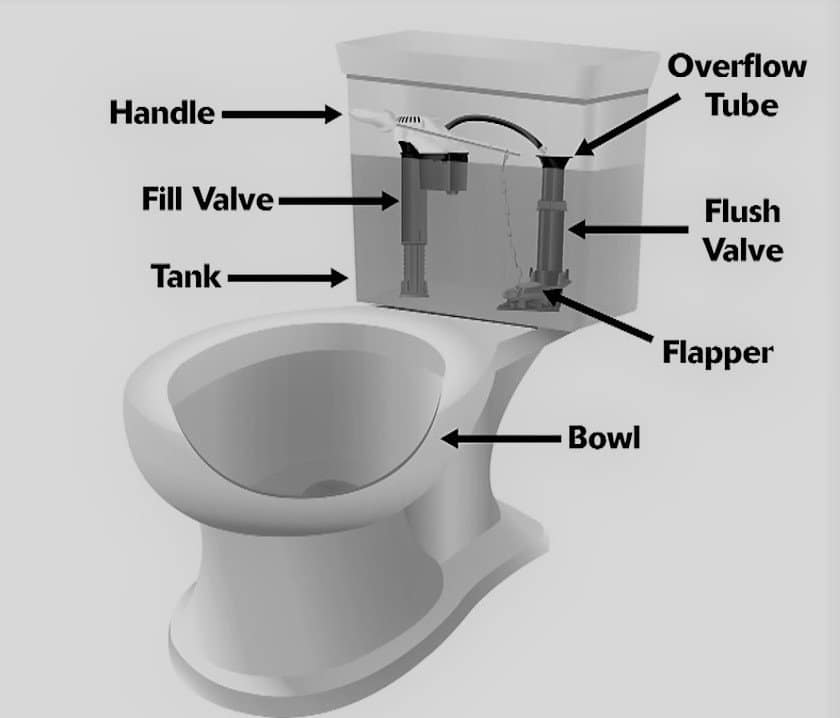
Both old and new toilet flushing systems work the same way, but if you look inside the toilet tank, they look a little different. Old and some new toilet tanks have a floating ball connected to the fill valve by a lever. Modern toilet tanks have a float cup positioned alongside the vertical body of the fill valve assembly.
The flushing handle is connected to a lift chain, which is connected to a flapper. When you push the flush handle down, the chain lifts off the flapper. Water from the tank enters the bowl via the flush valve using the force of gravity, and flushing happens.
After flushing, the flapper falls back to its position. At this point, the float ball/cup is at the bottom of the tank. When the toilet is not in use, the float ball/cup is supposed to float on top of the tank.
The float ball is connected to the fill valve via a lever. The fill valve is connected to the supply line from underneath the tank. When the float ball/cup is at the bottom of the tank, the fill valve is open, and water starts filling the tank as the float ball/cup moves up gradually.
When the float ball/cup reaches its set height, the tank is full, and the fill valve closes. This is the end of the flushing mechanism, and the toilet is ready for the next use.
If, on the other hand, you have a dual flush toilet, your toilet will have flush buttons at the top of the tank and will not have a lift chain or a flapper. This is how to fix a constantly running dual-flush toilet.
How to Stop a Running Toilet
If your toilet is constantly running, then it is one of these 3 toilet tank parts that have a problem:
- Toilet float
- The flapper
- Fill valve
These are the 5 ways to fix a running toilet:
- Adjust the toilet float
- Replace the toilet fill valve
- Adjust the flapper chain
- Clean the flapper
- Replace the flapper
The best way to fix a running toilet is to pick one toilet tank part at a time and troubleshoot it. In all of this, you will only need a screwdriver and an adjustable wrench.
1. The Toilet Float
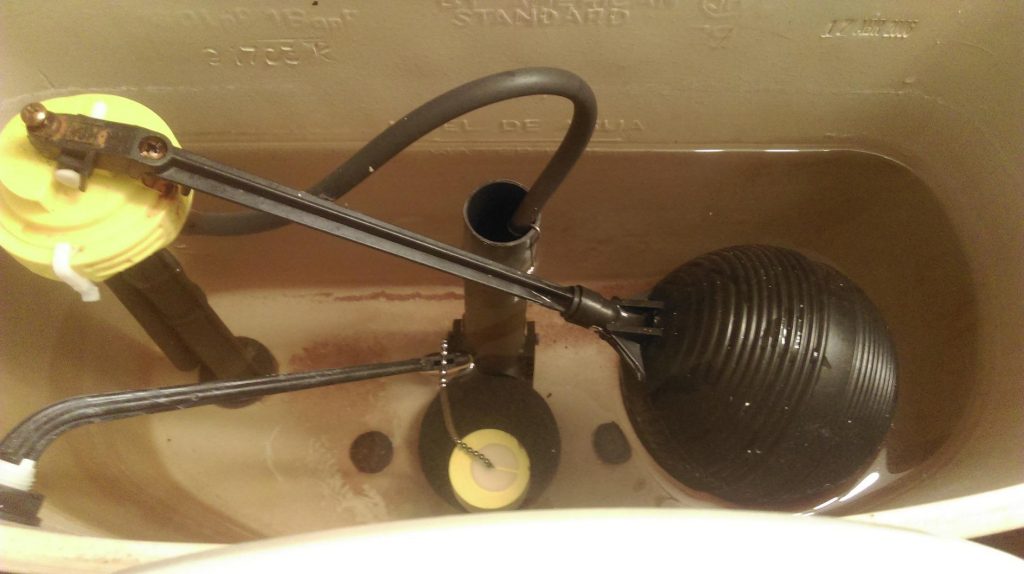
The downwards and upwards movement of the float ball/cup controls the opening and closing of the fill valve. It also controls the level of water in the tank.
If your float ball/cup is not properly adjusted, the water level in the tank will either be too low or too high. If the water level in your toilet is too high, it will start flowing into the overflow tube. Ideally, the water level in the tank should be about an inch or half an inch below the overflow tube.
The overflow tube is the toilet’s failsafe. It channels excess water in the tank back to the bowl, preventing the toilet from overflowing. If this is the case, your toilet will be running constantly.
If you have a float ball valve, some people recommend the following:
- Bend the float ball lever downwards if the tank water level is too high.
- Bend the float ball lever upwards if the tank water level is too low.
These methods are, however, not the best ways to go about it. So what should you do?
How to Stop a Running Toilet by Adjusting the Toilet Float
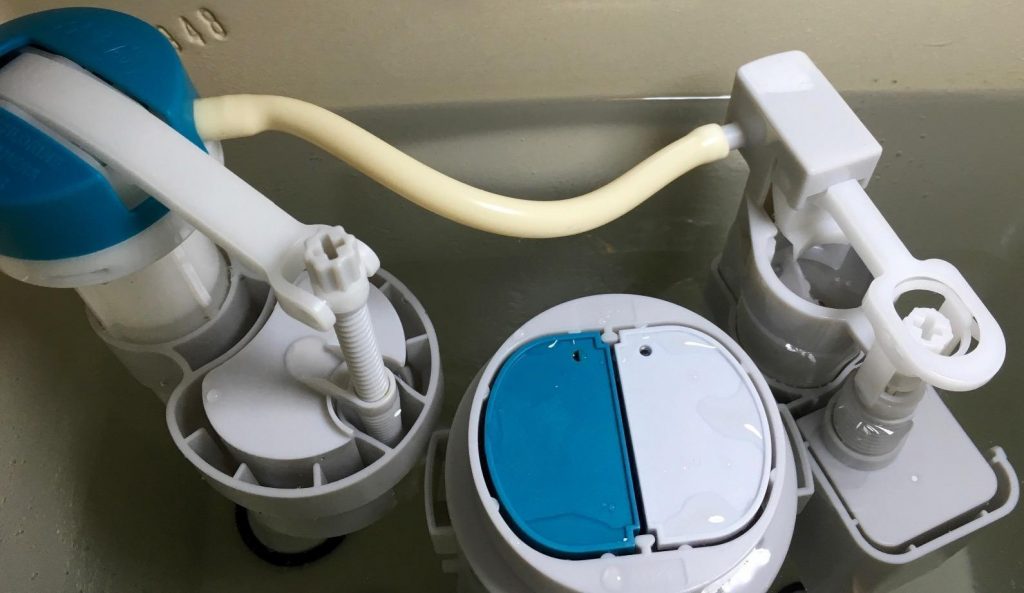
- If you have a float cup valve, look for a long plastic screw that is just adjacent to the float cup.
- Turn this screw clockwise with a screwdriver until the water lever is just about an inch below the overflow tube.
- If your toilet has a float ball valve, look for a screw where the float ball lever is joint to the fill valve assembly.
- Using a screwdriver, turn this screw in clockwise until the water level is an inch below the overflow tube.
If your problem is resolved, congratulations. You now know how to stop a running toilet. If the toilet tank water level is not the problem, let us look at other areas to troubleshoot.
2. The Toilet Flapper
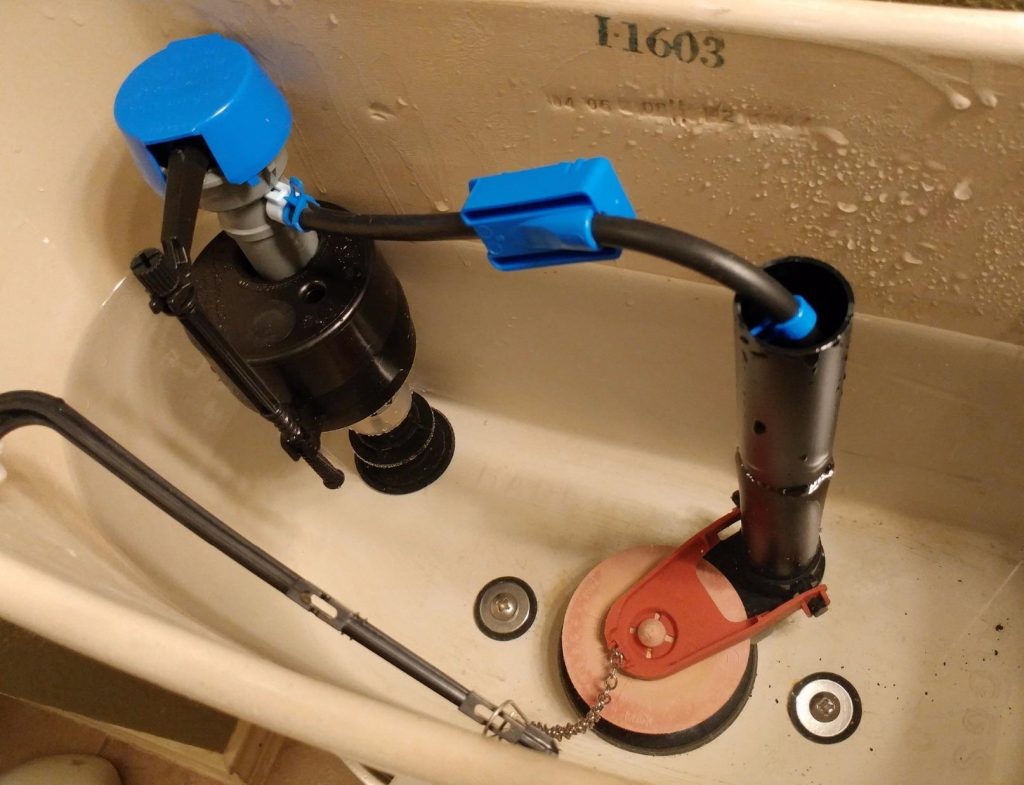
The toilet flapper is a rubber seal that prevents water from running into the toilet bowl all the time. It only lets water in the bowl when needed, during flushing. If it is defective, you will have a constantly running toilet.
How to Stop a Running Toilet by Fixing the Flapper
- Remove the tank lid.
- Check the condition of the lift chain. If it is tight, give it some slack! A tight lift chain could be slightly unseating the flapper from the flush valve resulting in continuous running.
- If the lift chain is slack, make sure the end of the chain is not hanging too low. The end of the chain can jam into the flush valve causing it not to sit properly.
- Also, check if the lift chain is hooking on anything to which it is not supposed to hook. This can also unseat the flapper.
- If the problem is unresolved, press down on the flapper with a finger or screwdriver. If the toilet stops running, then you have isolated your problem.
- Turn off the water supply to the toilet. The shut-off valve will be located on the wall behind the toilet. Turn it clockwise.
- Unhook the flapper from the lift chain and the overflow tube.
- Keenly check if there are mineral deposits or dirt trapped underneath it. Look out also for wear and tear. This happens primarily due to hard water causing it to warp.
- If the flapper is dirty, clean and dry it thoroughly. Put it back and see if there is a difference after turning on the water.
- If the flapper is, however, worn out or older than 5 years, just replace it this way
- If the toilet is still running, start troubleshooting the fill valve.
Alternatively, you can rebuild the entire toilet tank by replacing everything. These are the 7 best toilet tank repair kits.
3. The fill Valve
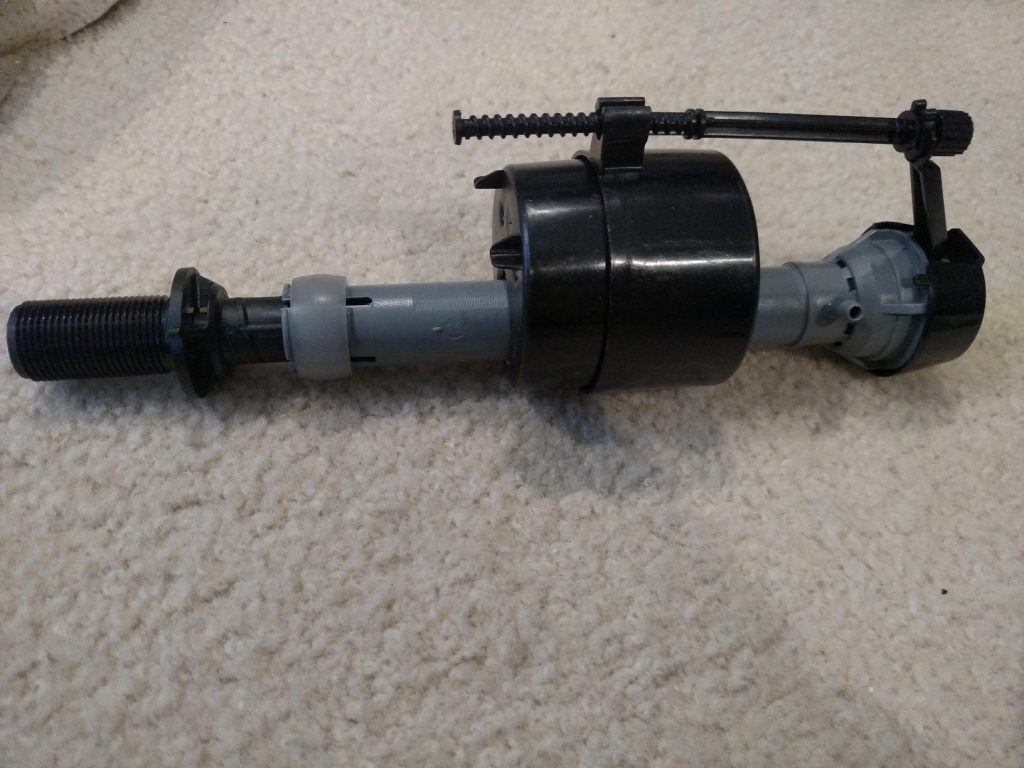
The toilet fill valve allows water from the supply line to fill the tank after every flush. Repairing a faulty fill valve is possible, but it is not worth it unless the fill valve is fairly new. The best option is to replace it. It is also not an expensive repair. A new fill valve costs about 20 dollars, and you can install it on your own in 10 minutes.
If you have a defective fill valve, it will continuously fill the tank with water flowing down to the bowl via the overflow tube, hence a constantly running toilet.
How to Stop a Running Toilet by Replacing the Fill Valve
- Turn off the water shut-off valve.
- Flush the toilet and hold the lever down to remove as much water as possible.
- Use your bare hands to disconnect the water supply line from the tank. Only use a wrench if it is too tight. Have a bucket underneath to drain the water already in the supply line.
- The fill valve is held in place by a lock nut from underneath the tank. Unscrew the lock nut.
- Unclip the refill tube from the overflow tube and pull out the fill valve.
- Adjust the fill valve. Ideally, the top cap of the fill valve needs to be about inches higher than the top of the overflow tube.
- To install the new fill valve, position it the way the old one was positioned. Screw and tighten the lock nut. Attach the refill tube to the overflow tube.
- Reconnect back the water supply line.
- Open the water shut-off valve.
- Adjust the level of the water in the toilet tank if necessary.
- Flush the toilet and see if the toilet has stopped running.
If you need to replace your toilet fill valve, here are the 5 best toilet fill valves.
99% of the time, the above 3 repairs are enough to stop a running toilet. If, for some reason, your toilet is still running, probably the flush valve is the culprit. In that case, here is how to replace a flush valve.
Conclusion
Toilets can last for a long time. Decades even. But in all this time, you will need to do repairs and maintenance on some of a toilet’s small and moving parts. Moving causes wear and tear. A running toilet can be caused by several factors. Knowing how to stop a running toilet can save you a lot of plumbing charges. Learning how to do it also improves your DIY confidence.
FAQs
How to stop a running toilet without a float ball?
If your toilet does not have a float ball, it has a float cup. A float cup is placed adjacent to the fill valve assembly. A float cup works the same way a float ball works. To stop a running toilet with a float cup just like one with a float ball, check the condition and possibly replace the flapper and the fill valve. Also, make sure the water level in the tank is below the overflow tube.
How to stop a running toilet with a button flush?
Most modern toilets use a flush button instead of a flushing lever. On the inside of the tank, they also look different. Flush lever toilet tanks have a floating ball or a floating cup, while flush button toilet tanks have a floating cup. Fixing a running toilet in both of these toilets is ideally the same. Check and make sure the tank water level is below the overflow tube. Then clean or replace the flapper and the fill valve.